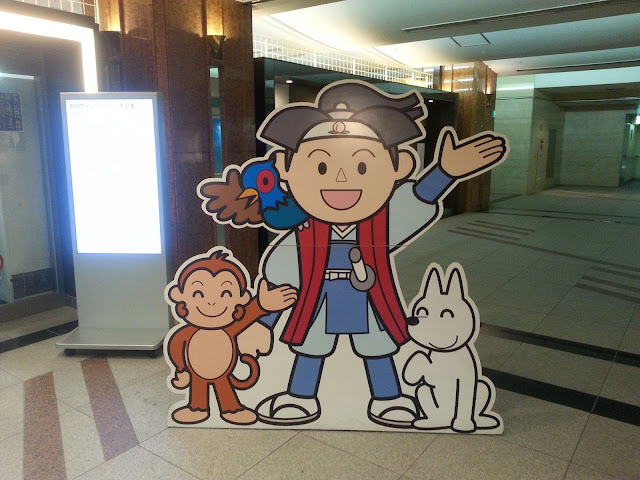Himeji, located in Hyogo Prefecture, is most famous for its magnificent castle: Himeji Castle (also known as White Heron Castle due to its elegant white appearance; in contrast to Okayama’s Crow Castle which I mentioned in my previous post). Out of Japan’s twelve original castles, it is widely considered to be the most beautiful. By original, I mean unlike many other Japanese castles, it was never destroyed by war, earthquake, fire, or any other causes. It was registered as Japan’s first inscription to UNESCO World Heritage Sites in 1993.
 |
A banner featuring Shiromaru-hime (Princess Shiromaru), the mascot of Himeji Castle
|
 |
| Outside Himeji Station |
The castle is a straight 15 to 20 minutes’ walk from Himeji Station. Thanks to summer holiday, it was flocked with visitors all around the world. I took a break after walking under extreme heat by eating kakigoori as usual. What made it interesting though, it was banana-flavoured! I noticed that this one particular vendor was selling kakigoori with unique flavours. I really wanted to try all of them but my ever-growing thinner wallet said no. Not to mention the entrance fee to Himeji Castle and its neighbouring garden costs 1,040 yen, the most expensive castle I’ve been to so far.
 |
| Street vendor selling kakigoori with unique flavours |
 |
| Banana kakigoori |
While the exterior of the castle is indeed outstanding, jaw-dropping even, there was almost nothing inside the castle except for the top floor which has a small shrine. And you can’t even see or enjoy it for long because of the crowd. The officers kept telling us to move forward. It was my worst castle-going experience ever despite it being famous, beautiful, and costly. Overrated? I think so.
 |
| Himeji Castle from afar |
 |
| Getting closer! |
 |
| An interesting X mark on one of its wooden pillars |
I prefer Nishinomaru, a long corridor located west of the castle. It has this peaceful atmosphere befitting that of a gorgeous castle. Of course you can still see the real castle.
 |
| Himeji Castle as seen from Nishinomaru ground |
Similar to Nishinomaru, the neighbouring Koukoen (lit. good old garden) received little to no attention from the visitors. The garden is divided to several sections (I guess the plants differ according to the sections?) and I was so happy to find out that it was not just green! It was a lovely garden, I should say. I will have the pictures speak for themselves.
P.S.: Due to the lack of photography skills, they may not seem all that pretty, so please note that the actual view is better.






















































